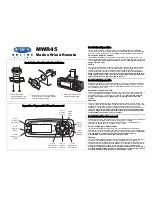
■
Connecting the units
NMEA1 connection
NMEA2 connection
■
Power source requirement
D
DC power source
The radar is designed for connection to any power
source if the voltage is 10.2–42 V DC, so that a 12, 24,
or 32 V DC battery can be used without a DC-DC con-
verter, or any internal modifications.
•
DC power cable connection
Connect the supplied DC power cable as shown in the
diagram.
■
Ground connection
To prevent electrical shocks and other problems, ground the display unit through the [GND] terminal on the unit’s
rear panel. For best results, connect a heavy gauge wire or strap to the nearest grounding point on the boat. The
distance between the [GND] terminal and the ground point should be as short as possible.
CAUTION
:
Incorrect cable connection may dam-
age the radar.
DC input
Ground
q
N TXT
(NMEA 2 output)
w
RXD
i
GND
u
N.C
y
AUX input (–); CLOCK
or N+1(–) data input
t
AUX input (+); CLOCK
or N+1(+); data input
r
NMEA 1 input (–)
or AUX input (–); DATA
e
NMEA 1 input (+)
or AUX input(+); DATA
NMEA1:
Bearing data input
NMEA2:
NMEA 0183 data input
Speed sensor input
+
;
Ground
Power supply
10.2 to 42 V DC
Red:
Black:
_
PWR
GND
NEVER
connect any-
thing other than the sup-
plied scanner unit.
Supplied scanner unit
9
INSTALLATION AND CONNECTIONS
24
q
NMEA 2
output (+)
w
NMEA 2
output (–)
e
NMEA 2
input (+)
u
GND (Speed sensor)
y
Speed sensor
input
t
Regulated 12 V output.
(20 mA Max.)
r
NMEA 2 input (–)
















































